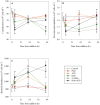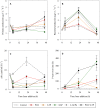DOP Stimulates Heterotrophic Bacterial Production in the Oligotrophic Southeastern Mediterranean Coastal Waters
- PMID: 31474972
- PMCID: PMC6706821
- DOI: 10.3389/fmicb.2019.01913
DOP Stimulates Heterotrophic Bacterial Production in the Oligotrophic Southeastern Mediterranean Coastal Waters
Abstract
Phytoplankton and heterotrophic bacteria rely on a suite of inorganic and organic macronutrients to satisfy their cellular needs. Here, we explored the effect of dissolved inorganic phosphate (PO4) and several dissolved organic molecules containing phosphorus [ATP, glucose-6-phosphate, 2-aminoethylphosphonic acid, collectively referred to as dissolved organic phosphorus (DOP)], on the activity and biomass of autotrophic and heterotrophic microbial populations in the coastal water of the southeastern Mediterranean Sea (SEMS) during summertime. To this end, surface waters were supplemented with PO4, one of the different organic molecules, or PO4 + ATP, and measured the PO4 turnover time (Tt), alkaline phosphatase activity (APA), heterotrophic bacterial production (BP), primary production (PP), and the abundance of the different microbial components. Our results show that PO4 alone does not stimulate any significant change in most of the autotrophic or heterotrophic bacterial variables tested. ATP addition (alone or with PO4) triggers the strongest increase in primary and bacterial productivity or biomass. Heterotrophic bacterial abundance and BP respond faster than phytoplankton (24 h post addition) to the various additions of DOP or PO4 + ATP, followed by a recovery of primary productivity (48 h post addition). These observations suggest that both autotrophic and heterotrophic microbial communities compete for labile organic molecules containing P, such as ATP, to satisfy their cellular needs. It also suggests that SEMS coastal water heterotrophic bacteria are likely C and P co-limited.
Keywords: DOP; P-turnover time; bacterial production; organic nutrients; primary production; southeastern Mediterranean Sea.
Figures



Similar articles
-
Impact of nutrient enrichment on productivity of coastal water along the SE Mediterranean shore of Israel - A bioassay approach.Mar Pollut Bull. 2018 Feb;127:559-567. doi: 10.1016/j.marpolbul.2017.12.048. Epub 2017 Dec 23. Mar Pollut Bull. 2018. PMID: 29475698
-
The Temporal Dynamics of Coastal Phytoplankton and Bacterioplankton in the Eastern Mediterranean Sea.PLoS One. 2015 Oct 16;10(10):e0140690. doi: 10.1371/journal.pone.0140690. eCollection 2015. PLoS One. 2015. PMID: 26474399 Free PMC article.
-
Nutrient Limitation in Surface Waters of the Oligotrophic Eastern Mediterranean Sea: an Enrichment Microcosm Experiment.Microb Ecol. 2016 Apr;71(3):575-88. doi: 10.1007/s00248-015-0713-5. Epub 2015 Dec 1. Microb Ecol. 2016. PMID: 26626911
-
Role of sea water DIP and DOP in controlling bulk alkaline phosphatase activity in N.W. Mediterranean Sea (Toulon, France).Mar Pollut Bull. 2012 Oct;64(10):1989-96. doi: 10.1016/j.marpolbul.2012.07.028. Epub 2012 Aug 4. Mar Pollut Bull. 2012. PMID: 22871673 Review.
-
Phosphorus physiological ecology and molecular mechanisms in marine phytoplankton.J Phycol. 2016 Feb;52(1):10-36. doi: 10.1111/jpy.12365. Epub 2016 Jan 11. J Phycol. 2016. PMID: 26987085 Review.
Cited by
-
Dissolved organic phosphorus bond-class utilization by Synechococcus.FEMS Microbiol Ecol. 2024 Aug 13;100(9):fiae099. doi: 10.1093/femsec/fiae099. FEMS Microbiol Ecol. 2024. PMID: 39003239 Free PMC article.
-
A dataset of global ocean alkaline phosphatase activity.Sci Data. 2023 Apr 13;10(1):205. doi: 10.1038/s41597-023-02081-7. Sci Data. 2023. PMID: 37055424 Free PMC article.
-
Changes in the Top-Down Control of Planktonic Bacteria in Response to Nutrient Addition and Warming in the Red Sea.Environ Microbiol Rep. 2025 Aug;17(4):e70166. doi: 10.1111/1758-2229.70166. Environ Microbiol Rep. 2025. PMID: 40751381 Free PMC article.
-
Heterotrophic Nitrogen Fixation at the Hyper-Eutrophic Qishon River and Estuary System.Front Microbiol. 2020 Jun 24;11:1370. doi: 10.3389/fmicb.2020.01370. eCollection 2020. Front Microbiol. 2020. PMID: 32670236 Free PMC article.
References
-
- Ammerman J. W., Azam F. (1991). Bacterial 5’-nucleotidase activity in estuarine and coastal marine waters: characterization of enzyme activity. Limnol. Oceanogr. 36 1427–1436. 10.4319/lo.1991.36.7.1427 - DOI
-
- Azov Y. (1986). Seasonal patterns of phytoplankton productivity and abundance in nearshore oligotrophic waters of the Levant Basin (Mediterranean). J. Plankton Res. 8 41–53. 10.1093/plankt/8.1.41 - DOI
LinkOut - more resources
Full Text Sources
Miscellaneous

